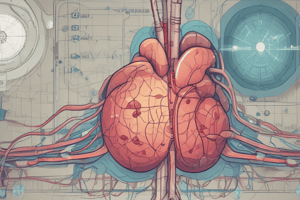Podcast
Questions and Answers
What factors influence Glomerular Filtration Rate (GFR)?
What factors influence Glomerular Filtration Rate (GFR)?
- Net filtration pressure and filtration coefficient (correct)
- Renal blood pressure and hormonal regulation
- Autoregulation and autonomic regulation
- Surface area of Bowman's capsule and permeability of glomerular capillaries
What are the three levels of control for GFR?
What are the three levels of control for GFR?
- Autoregulation, autonomic regulation, and hormonal regulation (correct)
- Renal blood pressure, filtration coefficient, and surface area
- Macula densa cells, afferent arterioles, and efferent arterioles
- Bowman's capsule, glomerular capillaries, and tubules
How does autoregulation maintain GFR?
How does autoregulation maintain GFR?
- By changing diameters of arterioles and capillaries (correct)
- By secreting ATP and adenosine
- By detecting changes in salt level of fluid
- By reducing blood flow into the glomerulus
What triggers dilation of afferent arterioles and capillaries?
What triggers dilation of afferent arterioles and capillaries?
What happens when renal blood pressure rises?
What happens when renal blood pressure rises?
What is the tubuloglomerular feedback mechanism?
What is the tubuloglomerular feedback mechanism?
What do macula densa cells secrete in response to increased salt level?
What do macula densa cells secrete in response to increased salt level?
What is the effect of constricting the afferent arteriole?
What is the effect of constricting the afferent arteriole?
Which level of control for GFR occurs at the local level?
Which level of control for GFR occurs at the local level?
What initiates autonomic and hormonal regulation of GFR?
What initiates autonomic and hormonal regulation of GFR?
What determines the filtration coefficient?
What determines the filtration coefficient?
Flashcards are hidden until you start studying
Study Notes
- Glomerular Filtration Rate (GFR) is influenced by net filtration pressure and filtration coefficient.
- Three levels of control for GFR: autoregulation, autonomic regulation, and hormonal regulation.
- Autoregulation maintains GFR by changing diameters of arterioles and capillaries.
- Reduced blood flow triggers dilation of afferent arterioles and capillaries, and constriction of efferent arterioles.
- Rise in renal blood pressure causes constriction of afferent arterioles and decreases glomerular blood flow.
- Tubuloglomerular feedback mechanism involves macula densa cells detecting changes in salt level of fluid.
- Increased salt causes macula densa to secrete ATP and adenosine, which constricts smooth muscles of adjacent afferent arteriole.
- Constriction of afferent arteriole reduces blood flow into the glomerulus and GFR.
- Autoregulation occurs at the local level, while autonomic and hormonal regulation are initiated by the kidneys.
- Filtration coefficient is determined by surface area of glomerular capillaries available for filtration and permeability of interface between capillary and Bowman's capsule.
Studying That Suits You
Use AI to generate personalized quizzes and flashcards to suit your learning preferences.




